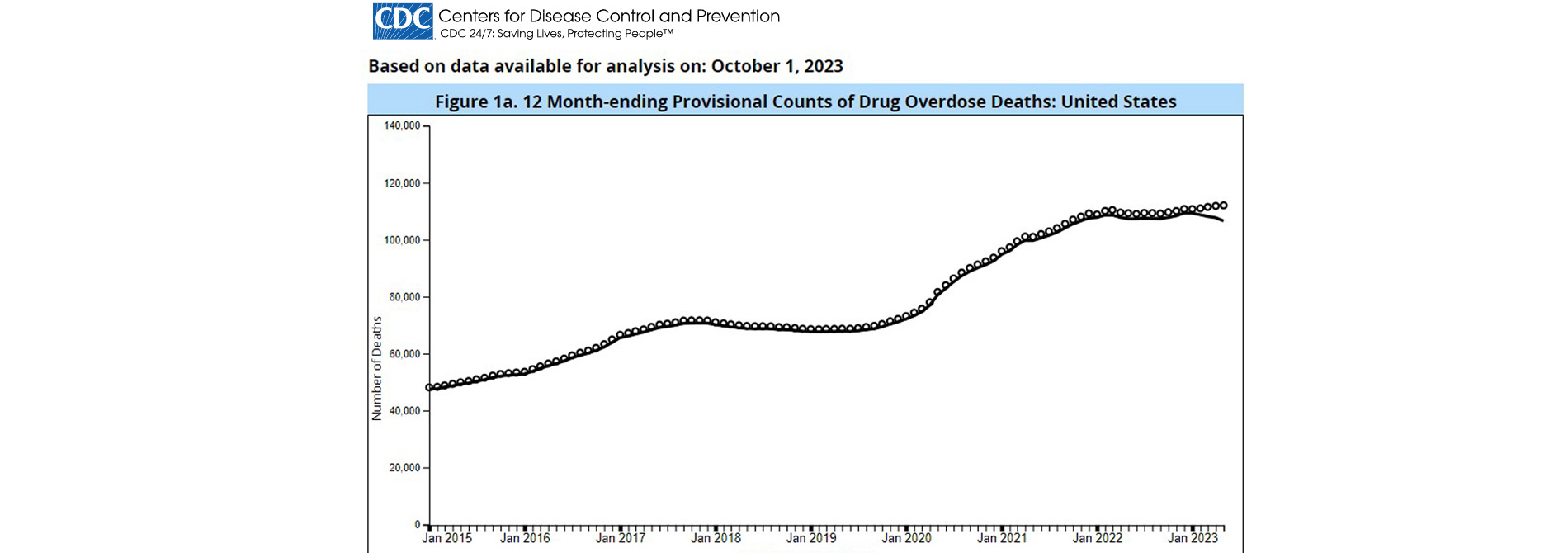An alarming surge in overdose deaths affects communities in every city and state. The crisis involves a variety of substances, with opioids, particularly synthetic opioids like fentanyl, as the most common contributor, and prescription painkillers, heroin, cocaine, methamphetamine, and benzodiazepines also on the list. In this blog post, we will help you learn how to reduce the risk of someone you know dying from an overdose and how to find them help for treatment and recovery needs.
If you or a loved one need help, call our admissions team today at 561-841-1033.The Center for Disease Control and Prevention (CDC) reports a concerning trend in drug overdose deaths, with 105,224 reported deaths in the United States over the 12-month period ending in March 2023. Regrettably, overdose-related fatalities have surged to become the leading injury-related cause of death in the nation. These overdoses can result from either intentional self-harm or accidental consequences, often involving substances tainted with dangerous additives like fentanyl. Mixing substances, whether intentionally or inadvertently, significantly heightens the risk of overdose, as the combined effects can be stronger and more unpredictable than using a single drug. For individuals grappling with substance use disorders, Hanley offers a solution with co-occurring disorder treatment, addressing both addiction and underlying mental health concerns, thus providing comprehensive support for a path to recovery.
Recent Overdose Deaths in the U.S.
The Center for Disease Control and Prevention (CDC) regularly releases provisional counts of drug overdose deaths, and the figures for the 12-month period ending in March 2023 are deeply concerning. During this period, the United States witnessed a staggering 105,224 drug overdose deaths, marking a distressing trend as overdoses have become the nation’s primary injury-related cause of death. Examining data from 2021 reveals the gravity of the situation, with over 106,000 deaths attributed to drug-involved overdoses. Of these, more than 70,000 involved synthetic opioids, primarily fentanyl, while over 16,000 were linked to prescription opioids. Cocaine-involved overdose deaths accounted for nearly 25,000 fatalities, and other psychostimulants, predominantly methamphetamine, contributed to more than 32,000 drug-related overdose deaths. The situation escalated in 2022 when the Drug Enforcement Administration (DEA) seized a shocking 58 million fentanyl-laced counterfeit pills across all 50 states. Disturbingly, six out of ten of these pills contained at least 2 milligrams of fentanyl, a dose considered lethal. This dire situation underscores the urgent need for comprehensive strategies to address the opioid crisis and prevent further loss of life.
Signs of Overdose
Overdose symptoms can vary widely, and the severity may depend on factors such as the substance used, dosage, and individual tolerance. The following list highlights some of the main signs for each substance mentioned.
Alcohol:
Confusion and stupor
Vomiting or severe nausea
Slurred speech
Slow, irregular breathing
Hypothermia (low body temperature)
Loss of consciousness or inability to wake up
Seizures
Cyanosis (bluish or pale skin, especially around lips or fingertips)
Benzodiazepines (e.g., Xanax, Valium):
Extreme drowsiness or sedation
Slurred speech
Muscle weakness
Slow, shallow breathing
Confusion and impaired coordination
Unresponsiveness or loss of consciousness
Cocaine:
Agitation and anxiety
Rapid heart rate and high blood pressure
Hyperthermia (elevated body temperature)
Chest pain and palpitations
Paranoia and hallucinations
Seizures
Stroke or heart attack
Opioids (e.g., heroin, fentanyl, prescription painkillers):
Slow, shallow breathing or respiratory arrest
Unresponsiveness or severe drowsiness
Pinpoint pupils (extremely constricted)
Bluish lips and nails due to oxygen deprivation
Muscle limpness
Loss of consciousness
Nausea and vomiting
Other Harmful Illicit Drugs:
Symptoms vary depending on the specific substance but may include extreme changes in behavior, vital signs, or consciousness. Seek immediate medical attention if an overdose is suspected.
Importance of Narcan
Possessing Narcan (naloxone), understanding how to use it, and understanding its limitations are all critical components of reducing the harm of opioid overdose situations. Narcan is an opioid antagonist that has the potential to save a person’s life by swiftly reversing the life-threatening effects of opioids. However, it is essential to recognize that the effects of Narcan are only temporary, and qualified medical attention is still required. Opioids are exceedingly strong, and an overdose can result in a variety of consequences even after Narcan is administered. Immediate medical attention can address these issues and provide thorough care, increasing the likelihood of a full recovery.
Getting Help with Hanley
Individuals with a history of drug or alcohol overdoses require treatment because it tackles the underlying reasons for addiction, provides a safe medical detox, and prepares them with coping techniques for long-term recovery. Hanley recognizes the value of holistic therapy and provides customized programs tailored to each individual’s specific needs. These programs treat addiction and co-occurring mental health concerns, as well as physical, mental, and emotional well-being. Hanley helps patients develop a strong foundation for long-term sobriety by concentrating on the whole person, lowering the chance of future overdoses, and allowing them to take control of their lives in a supportive and compassionate atmosphere.




